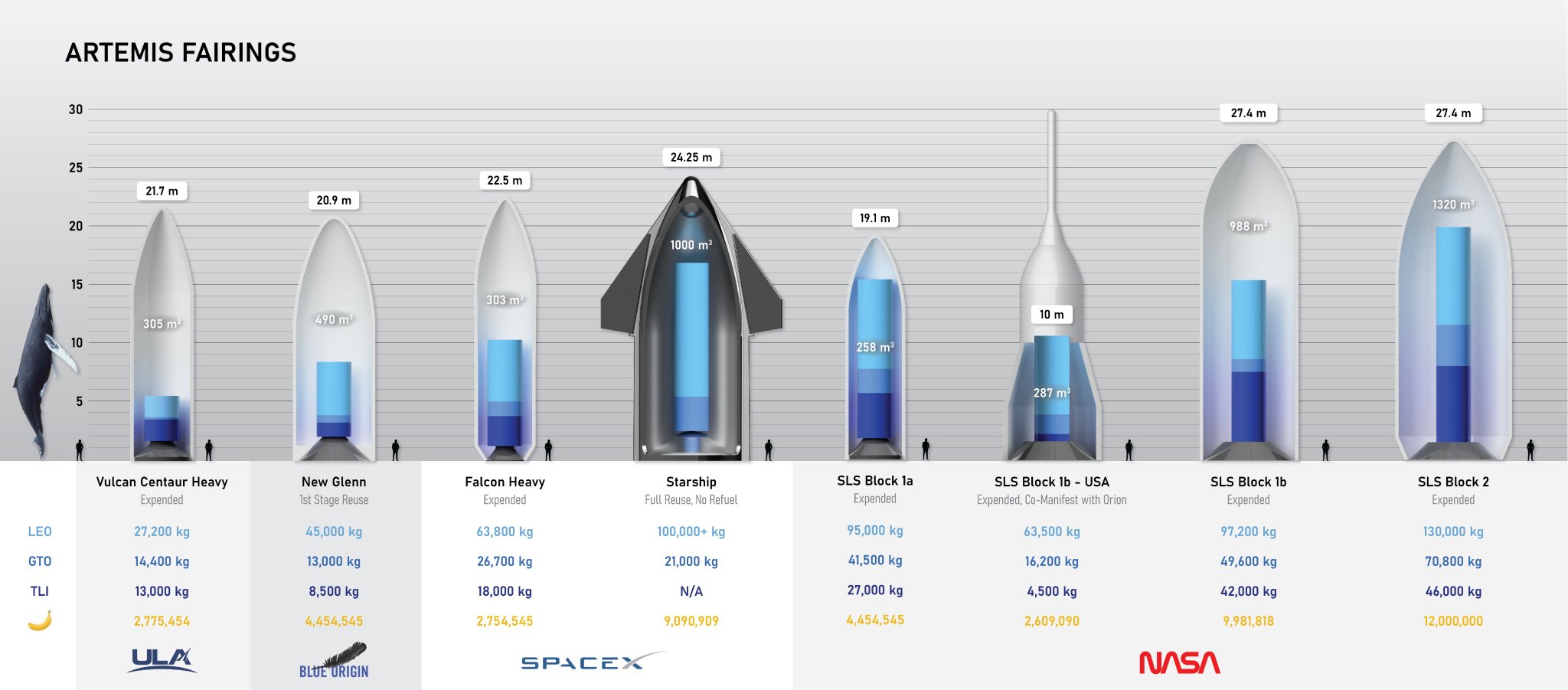@FreddieR's answer to What are the longest current rocket payload fairings, capable of carrying long space station sections? contains the following graphic. It's attributed to Ken Kirtland and I found a copy in DBS Larssson's tweeted graphic of LEO, GTO and TLI payload capabilities for heavy haul launch vehicles (shown below).
Eight vehicle/configuration combinations are shown and for each there are four numerical values. The first are payload mass capabilities to LEO, GTO and TLI in kilograms, but the last is labeled with a picture of a banana and the numbers are (accordingly) in yellow. No units are shown and the banana values range from 2.6 to 12 million.
It's interesting to note that the banana values generally have repeating digits, which may (or may not) be a clue.
Question: What do the banana values mean in this tweeted plot of heavy lift vehicle capabilities?
I've typed out the values here (and plotted below)
Vehicle, configuration and use LEO GTO TLI bananas
--------------------------------- ----- ----- ----- ---------
Vulcan Centaur Heavy \n Expended 27.2 14.4 13 2775454
New Glenn \n 1st Stage Reuse 45 13 8.5 4454545
Falcon Heavy \n Expended 63.8 26.7 18 2754545
Starship \n Full Reuse No Refuel 100 21 n/a 9090909
SLS Block 1a \n Expended 95 41.5 27 4454545
SLS Block 1b - USA \n
Expended, Co-Manifest w/ Orion 63.5 16.2 4.5 2609090
SLS Block 1b \n Expended 97.2 49.6 42 9981818
SLS BLock 2 \n Expended 130 70.8 46 12000000
import numpy as np
import matplotlib.pyplot as plt
info = (('Vulcan Centaur Heavy \n Expended', 27.2, 14.4, 13, 2775454),
('New Glenn \n 1st Stage Reuse', 45, 13, 8.5, 4454545),
('Falcon Heavy \n Expended', 63.8, 26.7, 18, 2754545),
('Starship \n Full Reuse No Refuel', 100, 21, 0, 9090909),
('SLS Block 1a \n Expended', 95, 41.5, 27, 4454545),
('SLS Block 1b - USA \n Expended, Co-Manifest w/ Orion', 63.5, 16.2, 4.5, 2609090),
('SLS Block 1b \n Expended', 97.2, 49.6, 42, 9981818),
('SLS BLock 2 \n Expended', 130, 70.8, 46, 12000000))
data = np.array([line[1:-1] for line in info])
names = [''] + [line[0] for line in info]
nicknames = '', 'VCH', 'NG', 'FH', 'STR', 'SLS1a', 'SLS1bco', 'SLS1b', 'SLS2'
labels = 'LEO', 'GTO', 'TLI'
LEO, GTO, TLI = data.T
TLI_to_LEO = TLI/LEO
GTO_to_LEO = GTO/LEO
if True:
fig, (ax1, ax2) = plt.subplots(2, 1, figsize=[7, 10])
for thing, label in zip(data.T, labels):
ax1.plot(thing, label=label)
ax1.legend()
ax1.set_xticklabels(nicknames)
ax1.set_ylabel('metric tons', fontsize=10)
ax2.plot(GTO_to_LEO, label='GTO/LEO')
ax2.plot(TLI_to_LEO, label='TLI/LEO')
ax2.set_xticklabels(names, rotation = 90, fontsize=8)
ax2.legend(loc='best')
plt.subplots_adjust(left=None, bottom=0.35, right=None, top=0.98,
wspace=None, hspace=None)
plt.show()


